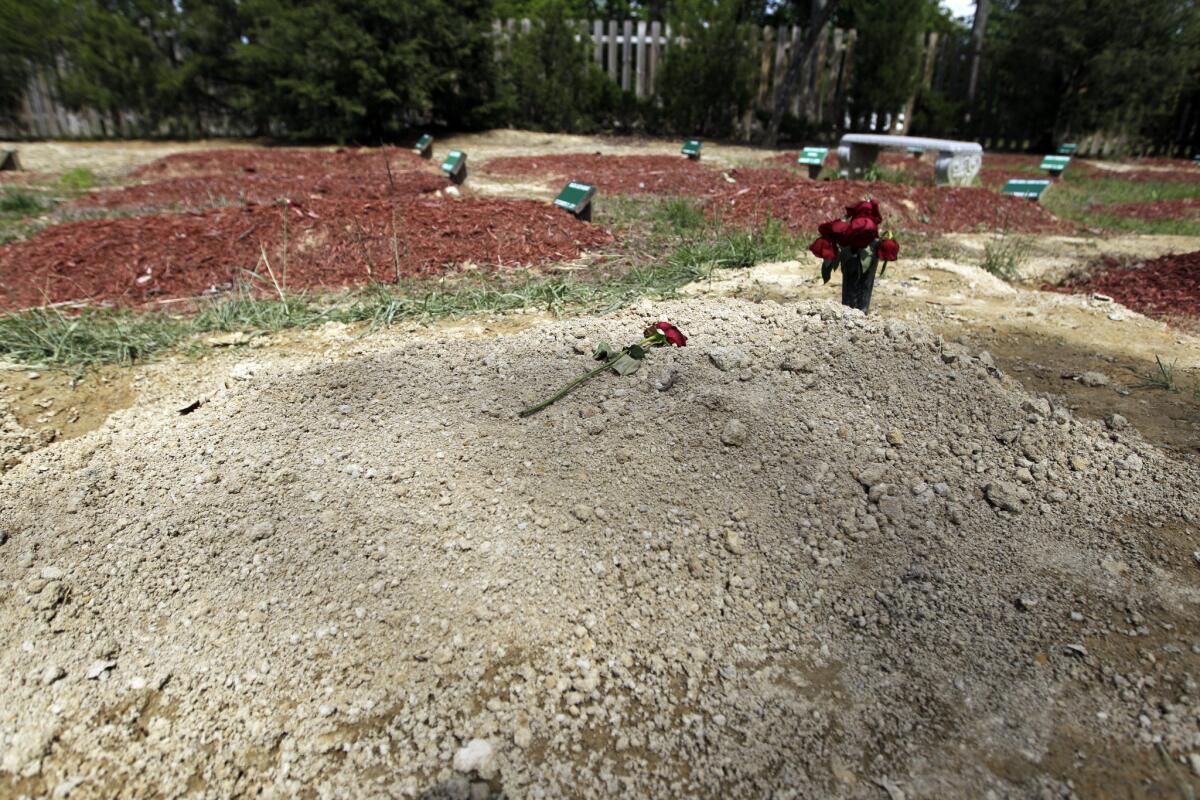Tamerlan Tsarnaev: Not just any body

- Share via
If you don’t believe in souls or an afterlife, then a corpse is just a body — potentially a teaching tool, a source of life-saving organs, but little more.
In 1829, taking such thinking to the extreme, a radical British pamphleteer named Peter Baume specified that after his death, his skeleton was to be donated for medical education or, failing that, his bones made into knife handles and buttons; his skin was to be tanned to make a chair cover, and his soft body parts used as fertilizer for roses.
Generally speaking, I’m with Baume. But the vast majority of humans, through much of our collective history, have seen things differently. And they still do today, as evidenced by the recent uproar over how to handle Tamerlan Tsarnaev’s remains.
For more than two weeks, Tsarnaev’s corpse was held in a funeral home in Worcester, Mass., as cemeteries around New England refused his remains. “Bury the Garbage in the Landfill” read one protest sign. As one man, speaking outside a Connecticut cemetery that was being considered as a burial site, told ABC News, “We’ll do anything within our power to keep this guy out of here.”
It was as if “this guy” retained his mortal attributes and would be a dangerous presence in an otherwise safe neighborhood. Another protester objected to Tsarnaev’s interment at the cemetery because “there are a lot of Civil War and Revolutionary [War] veterans that rest peacefully here.” As if 200-year-old skeletons would care.
The reaction wasn’t all that surprising. Intense feelings are commonplace when it comes to human bodies. Savage battles have been halted to exchange the dead. People risk death to retrieve fallen comrades — consider the extreme dangers faced by the divers in 2001 who volunteered to recover corpses from the sunken Russian submarine Kursk. Native Americans and paleontologists battle in courts over possession of 10,000-year-old bones. And when the United States gave up the Panama Canal, along with the VCRs and microwaves shipped back home came the bodies from the American cemetery.
It was clearly a considered decision that Osama bin Laden’s body was dumped at sea before
his apprehension was even announced. The body would have become a huge political issue if it had been left in Pakistan or brought to the United States.
When viewed from an objective distance, human attitudes toward corpses seem even stranger. Consider an event recounted in the book “Grave Matters” by the anthropologist Nigel Barley of the British Museum. It concerned the death in 1231 of Elizabeth of Thuringia, destined to become St. Elizabeth of Hungary. This was someone so clearly bound for sainthood that after she died, a crowd quickly dismembered her body because they wanted holy relics.
Even more bizarre is the story recounted by Barley of the 11th century St. Romuald. In his old age, he made the mistake of mentioning his intention of moving from his Umbrian town; the locals, worried that some other burg would wind up with the holy relics of his body, promptly conspired to murder him.
These varied examples can be explained in this succinct statement by Barley: “The dead do not own their own corpses.”
Instead, a body is an opportunity for its possessors to express their values. They can do so with a 21-gun salute. By dragging the body through the streets. By preserving it for future generations to revere (consider the mummification of Lenin by the Soviets). By dumping it in an unmarked grave that the deceased was forced to dig. By having anatomists dissect it publicly (as was done with the executed during Henry VIII’s time). By cooking and lovingly eating it (as done by the Fore people of New Guinea upon the death of a parent). A body is an unmatched opportunity to affirm, revitalize, inculcate and share group values.
And what about our own group values, as we consider the body of Tamerlan Tsarnaev? He was clearly considered by the protesters, and by most Americans, as an ideological enemy whose goal was to spread terror, to kill and maim the innocent. But does that mean his body should be reviled after death?
We have many tough junctures ahead of us in a world that can produce a Tamerlan Tsarnaev. And when the going gets tough, the tough have to choose prudently among conflicting values, amid the strong emotions that initially push some of those choices to the forefront. In the wise words of Worcester Police Chief Gary Gemme during the search for a place to bury the body: “There is a need to do the right things. We are not barbarians. We bury the dead.”
Eventually, that is exactly what happened. A Virginia woman who works as a mental health counselor and trained at a Methodist seminary was bothered by what she saw as “hatred and bigotry” and made it her mission to find someplace willing to take Tsarnaev’s body. He is now buried in a cemetery near Richmond. We don’t know how the other corpses feel about their new neighbor.
Robert M. Sapolsky is a professor of neuroscience at Stanford University and the author of “A Primate’s Memoir,” among other books. He is a contributing writer to Opinion.
More to Read
A cure for the common opinion
Get thought-provoking perspectives with our weekly newsletter.
You may occasionally receive promotional content from the Los Angeles Times.









